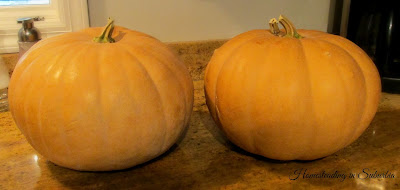Let's start with the benefits of pumpkin....
- AIDS VISION; a cup of cooked, mashed pumpkin contains more than 200% of the recommended daily of Vitamin A, carotenoids and beta-carotene.
- LOW CALORIE; 3 grams per cup of pumpkin is only 49 fiber rich calories.
- REDUCED CHOLESTEROL; Pumpkin Seeds are naturally rich in phytosterols which may help reduce LDL levels and tryptophan which has shown to improve moods.
- REFUEL A TIRED BODY; one cup of cooked pumpkin has up to 564 milligrams of potassium.
- VITAMIN C; upwards of 11 milligrams can be found in one cup of cooked pumpkin.
Wouldn't you agree that it IS worth the effort and time commitment? I would. Yes, you can buy a can of it at the store, even get the organic, I have. However, if I have the opportunity and time to make my own, I always take that option. I'd prefer the only processing of my puree to be my Kitchen stove and a glass jar and not a commercial processing facility.
Ok, enough of that, on to making your own puree:
You can use any pumpkin but I prefer "milk pumpkins" or also known as "sugar pumpkins".
They are lighter in color than what you normally see.
Give them a good scrubbing.
Cut open the pumpkin and scoop out the innards.
You can either compost or save the seeds and roast them.
Slice into chunks that will fit into your pot, cover with water and boil until soft. Depending on how big your pumpkin is and how much fits in the pot, it can take up to 30 minutes or longer to soften.
Remove sections from the pot, BE CAREFUL, the pieces will be very hot, let them cool a few minutes. Use a spoon to scrape the pulp from the skin (the skin goes in the compost too).
This is the undrained pulp from one large pumpkin.
Using a colander, let the pulp drain until most of your water is out and give it a stir every now and then. This takes quite a while, up to 2 hours in most cases.
This is what drained from one of my pumpkins, nearly 7 cups of water!
As you can see, draining the pulp is important.
You're done! It's probably taken all day BUT well worth the effort in my book.
What I see here is 9 pumpkin pies to be made any time I want!
A few tips:
I normally do this on a weekend. I'll get everything cut up, boiled and draining started then go about my day, passing by every so often to give it a stir.
Any pumpkin works but Sugar Pumpkins have a nice taste which I prefer for recipes.
If you like your pies a little rustic like me, there's no need to do anything further after draining. If you like it smoother use either a potato masher, blender or immersion blender to achieve the desired consistency.
I use a mesh strainer and cheesecloth only because I find it easier to clean up. Any small-holed strainer will do.
Store puree in the freezer in freezer-safe jars, BPA-free plastic containers or Ziploc Bags, removing as much air as possible. I prefer the glass jars since they are reusable and easy to clean. When you're ready to defrost, put it back into a collander while you prepare your recipe. A little more water will drain from being frozen.
You CANNOT safely can pumpkin puree either with a Pressure Canner or Water Bath Canning. There is no safe way, other than freezing, for long term storage.
You CAN Pressure Can pumpkin chunks.
You can find my favorite Pumpkin Pie recipe here. I've been making the same recipe for over 20 years and it's perfect every time.
If I were to buy 9 fresh pumpkin pies at a bakery, it would cost me $20 per pie. Yep, 20 bucks!
The pumpkin cost me $6 so that's 67 CENTS per pie plus another $2 for ingredients. Total $2.67 for homemade, nutrient-rich pumpkin pie.
To me that's worth the effort. Wondering if it's worth your time and effort?
Try it. Compare a pie made with your fresh puree and another with canned. I promise you'll be shocked at the taste. And if not, well, you learned something new, you have a few jars of puree and a good story to tell.





















































